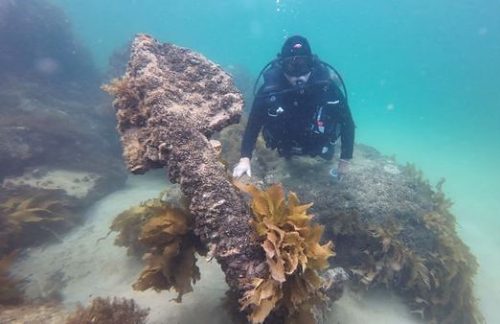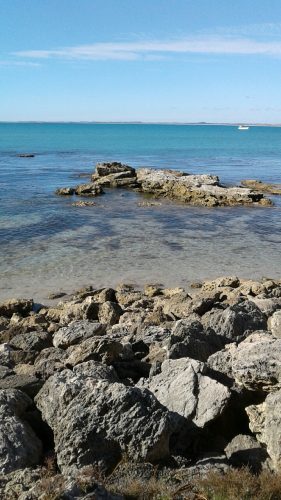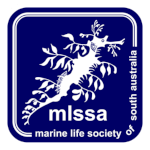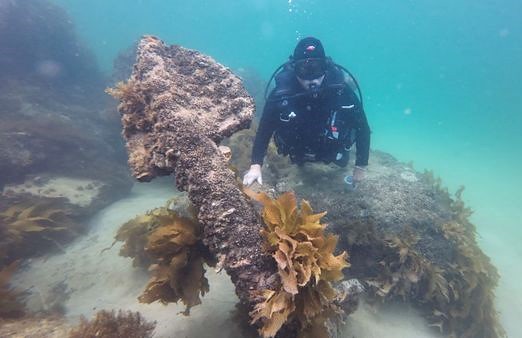It seems that there have been several spellings/miss-spellings for the name of the ship Duilius wrecked in Guichen Bay in 1853.
Here is one such discrepancy, in “Wrecks on the South Australian Coast (including Kangaroo Island)” by Jack Loney: –

(Source: “Wrecks on the South Australian Coast (including Kangaroo Island)” by Jack Loney)
The spelling is given as ‘Duluis’, rather than ‘Duilius’.

The coast at Robe
(As reported at both The Signal(?) Cannon at Robe and Possible origins of the large anchor at Port Noarlunga reef, “The Duilius was anchored in Guichen Bay loading wool for London on 9th April (1853) when a strong north-west gale sprang up and buffeted the ship. The prevailing gale caused the ship to lose two anchors. The wind eventually moderated slightly on the 15th April and Captain W.Maxton took the opportunity to move his ship further from the shore. The anchor broke at the stock when there was a sudden jerk as the cable was being hove in. With no large anchor left, Captain Maxton could only run the ship ashore. It struck a rock and filled with water before settling on the bottom. Captain Maxton abandoned the ship and it became a total loss…”

The anchor at Port Noarlunga reef
(Taken by Alex Wyschnja)
“Wrecks on the South Australian Coast (including Kangaroo Island)” by Jack Loney says that it was 1am on the 15th April when one of the anchors parted. It describes the Duilius as a wooden, 3-masted barque of 327 tons built in 1840. Brief details about the wrecking can also be found in “Wrecks on the South Coast of South Australia” by Loney.)
Then there is the caption for a photo of a cannon on page 61 of “Wrecks on the South Australian Coast (including Kangaroo Island)” by Loney: –

(Source: “Wrecks on the South Australian Coast (including Kangaroo Island)” by Jack Jack Loney)
Here the name is spelled as ‘Duiluis’, so we have 3 different spellings so far – ‘Duilius’, ‘Duluis’ and ‘Duiluis’.
I have just come across a book titled “The Sixth Eleven Tales of Robe” by (Pro?) Kathleen Bermingham published in 1975. According to the book, there had been five different spellings used for the name of the ship. The most popular name used has been ‘Dieulius. “Dulius’ is apparently the fifth spelling.
Bermingham says that the true spelling is revealed by a silver dessert spoon bearing the name of the ship. The spoon was then located at a private museum of Mr Alexander Barrowman: –
“In this museum is a silver dessert spoon with the name “Duilius” inscribed on the handle. This inscription has settled a controversy, of years’ standing, which claimed five alternative spellings for this vessel, the most popular being the “Dieulius”.
Bermingham says that the Duilius “broke her moorings during the night of 15th April, 1853 and was wrecked about a mile to the south-east of the first jetty (at Robe?). After having broken her moorings, she was driven ashore before having completed the taking-in of her cargo – the first wool ever to have been loaded at Guichen Bay for the London market.”
The salvaged wool was stored in two buildings whilst awaiting its auction. One of those buildings was the one used as the private museum of Mr Alexander Barrowman which had the silver dessert spoon with the name “Duilius” inscribed on the handle.
According to the web page found at https://www.austlit.edu.au/austlit/page/A6728 , “Alexander Hutchison Barrowman (was) Born: 28 Aug 1905 Robe, South Australia ; Died: 1987”.
(According to the biography given for him, “Alexander Barrowman was a descendant of the large Hutchinson(?)-Dunn family, prominent early graziers in the south east of South Australia. His mother, a teacher, died when he was an infant. The youngest of four brothers, Barrowman’s only schooling was at the Primary School at Robe, which was then a small and remote seaside town. Later, in Adelaide, he worked as a wireless operator at radio 5DN (1926-1929). He then became a freelance journalist and writer until the onset of World War II. Barrowman volunteered and spent several years in the RAAF driving motor transports in Darwin, Bathurst Island and New Guinea.
“After the war Barrowman settled permanently in Robe, becoming involved in the life of the town, and he later ran a small general store with a private museum attached. He had a wide range of interests and was particularly drawn to the history of the south east of South Australia. He had some articles and letters published in country newspapers and, in 1971, self-published a collection of essays and poems, Old Days and Old Ways. He also published a Souvenir of Historic Robe in 1979.”)

The coast at Robe
The other building where some of the salvaged wool was stored whilst awaiting its auction was “Grey Masts” which was once located on a corner block on Smillie Street.
As previously reported, the cannon at Robe and the anchor at Port Noarlunga reef have both been thought to be from the Duilius.

